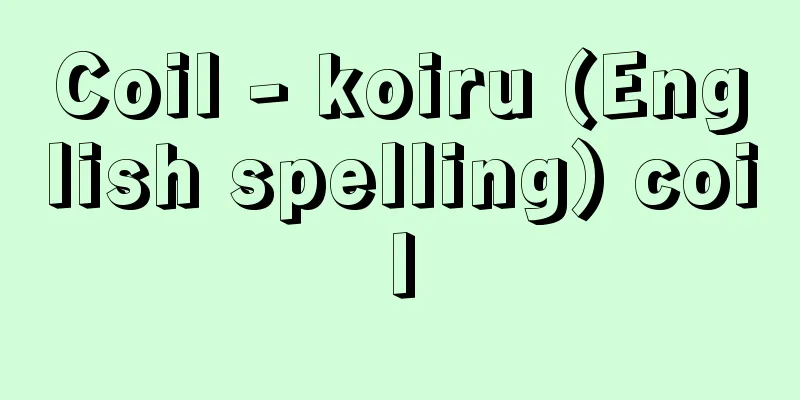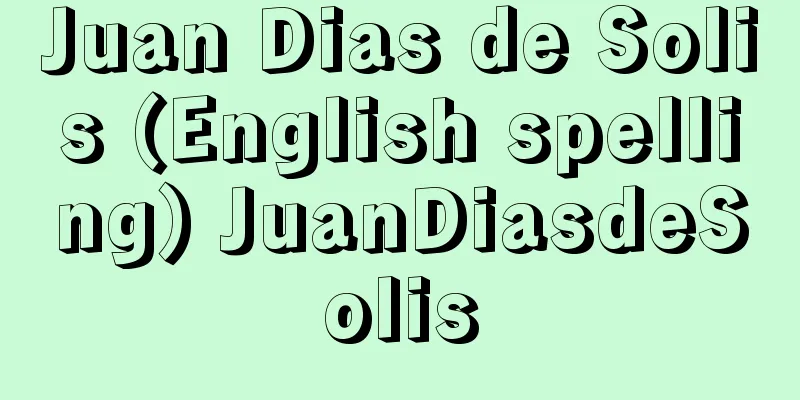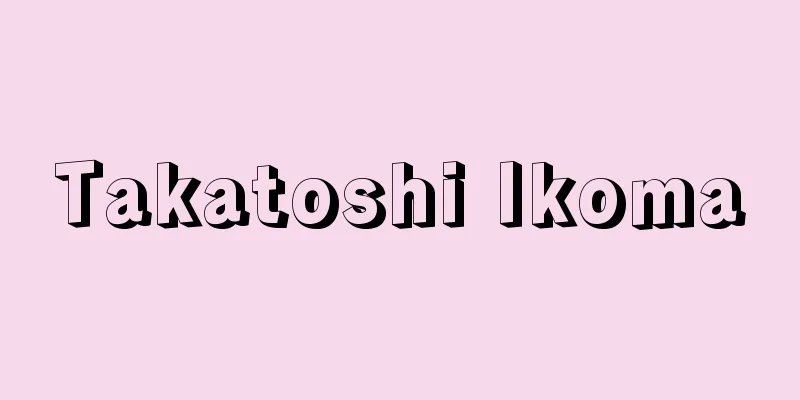Coil - koiru (English spelling) coil

|
An electric conductor wound into a cylindrical shape. Also called a coil. When a direct current flows through a coil, it generates a magnetic field proportional to the number of turns times the strength of the current. So-called electromagnets are coils with an iron core placed in the center. When the current flowing through the coil changes, an electromotive force is generated in the coil that opposes the change in current. This electromotive force is proportional to the rate of change of the current, and acts as an inductive reactance that acts the same as resistance for alternating current, and is proportional to the frequency, and the proportional constant is called inductance. A coil that forms an inductance is also called an inductor, and can be broadly divided into cored and air-cored types. Cored types have a magnetic core made of a metal or oxide magnetic material placed in the center of the coil to increase inductance. In this case, metal magnetic cores are rarely used at frequencies above 10 kHz because of the large loss caused by eddy currents. Conversely, metal magnetic cores are mainly used below 10 kHz because oxide magnetic cores have low saturation magnetization and magnetic permeability. Air-core coils do not contain a magnetic core. They have a small inductance and are used in high-frequency choke coils, as well as in series reactors for power applications that require high power to avoid saturation caused by the magnetic core. Coils can be wound in a single layer or in a multilayer. Since the inductance of a coil is proportional to the square of the number of turns, multilayer winding is advantageous for obtaining a large inductance. However, as the number of turns increases, the distributed capacitance also increases, making winding difficult, especially in the high frequency range. For this reason, winding methods that reduce capacitance, such as bank winding, honeycomb winding, and pie-filament winding, have been devised. For high power applications, the electrical conductors are also relatively thick, and a winding method in which copper rods are stacked and joined together to form each layer, is sometimes used. For high frequencies, formal wire is used, and thinner wires are used as the frequency increases. Metallic magnetic materials used for magnetic cores include silicon steel, permalloy, and perminvar. All of these are used in the low frequency range, such as commercial and audio frequencies, and are made into laminated cores by stacking thin plates to reduce losses due to eddy currents. As for oxide magnetic materials, ferrite is used in the high frequency range, and pressed iron cores are used in the even higher frequency range. [Michinori Iwata] [Reference items] | |©Shogakukan "> Classification by coil winding method ©Shogakukan "> Classification by coil core shape Source: Shogakukan Encyclopedia Nipponica About Encyclopedia Nipponica Information | Legend |
|
電気導線を円筒状に巻いたもの。線輪(せんりん)ともいう。コイルに直流電流を流すと、巻き数と電流の強さの積に比例した磁界を生じる。いわゆる電磁石はコイルの中央に鉄心を入れたものである。このコイルに流れる電流が変化すると、電流の変化を妨げるような起電力がコイルに生じる。この起電力は電流の変化率に比例し、交流電流に対しては抵抗と同じ役割をする誘導性リアクタンスとして、周波数に比例して働くが、その比例定数をインダクタンスとよぶ。インダクタンスを形成するコイルを誘導子ともいい、大別すると有心型と空心型に分けられる。有心型はコイルの中央に金属磁性体か酸化物磁性体の磁心を入れ、インダクタンスを大きくしたものである。この場合、金属磁性体磁心は渦(うず)電流による損失が大きいので、10キロヘルツ以上の周波数ではほとんど用いない。逆に10キロヘルツ以下では、酸化物磁性体磁心は飽和磁化、透磁率が小さいので、金属磁性体磁心がおもに使われる。空心型はコイルの内部に磁心を含まない。インダクタンスは小さく、高周波用のチョークコイルなどに使用されるほか、大電力が要求される電力用の直列リアクトルにも、磁心による飽和現象を避けるために使われる。 コイルの巻き方には、単層巻きと多層巻きとがある。コイルのインダクタンスは巻き数の2乗に比例するので、大きなインダクタンスを得るためには多層巻きが有利である。しかし、巻き数が多くなると分布キャパシタンスが大きくなることから、とくに高い周波数域では巻き方がむずかしくなる。このため、バンク巻き、ハニカム巻き、パイファイラ巻きなど、キャパシタンスを小さくする巻き方がくふうされている。大電力用の場合は電気導体もそれなりに太くなり、板棒状の銅を積み上げて各層を接合させる巻き方をすることもある。高周波用にはホルマール線などを用い、周波数が高くなるにつれ細い線を用いる。 磁心に用いる金属磁性材料には、ケイ素鋼板、パーマロイ、パーミンバールなどがある。いずれも商用周波数、可聴周波数など低い周波数域で用いられ、渦電流による損失を減らすため、薄板を積み重ねた成層磁心としている。酸化物磁性材料としては、高周波域ではフェライトが用いられ、さらに高い周波数域では圧粉鉄心が用いられる。 [岩田倫典] [参照項目] | |©Shogakukan"> コイルの巻き方による分類 ©Shogakukan"> コイルの磁心の形状による分類 出典 小学館 日本大百科全書(ニッポニカ)日本大百科全書(ニッポニカ)について 情報 | 凡例 |
Recommend
Brosse (English spelling) Salomon de
[Born] 1571. Verneuil Died December 9, 1626. Frenc...
Sun's anteroposterior
The direction in which the Sun moves relative to ...
Deliquescence
When the vapor pressure in equilibrium with a sat...
Dokushi Hokyo Journal - Dokushi Hokyo Journal
This is a 130-volume historical geography book wr...
Ekka - Ekka
...The third layer contains mammal-like reptile f...
Bookplate - Zoshohyohyo (English spelling)
A label affixed to the inside of a book to indica...
Dollar diplomacy - dorugaikou (English spelling) dollar diplomacy
Originally, it was a term that characterized the ...
Bathilda
…A monastery founded in Amiens, Somme, in north-c...
Ilmenite (English spelling)
One of the ore minerals of titanium. The ores tha...
Food coloring - food coloring
A food additive. A coloring agent used to color fo...
Appassionata - Appassionata
...As a result, the contents of this will are now...
Camembert cheese
…Similar cheeses made in various countries using ...
Swaging - Swaging (English spelling)
A type of forging process in which metal material...
Amanohiwashi no Mikoto - Amanohiwashi no Mikoto
A god who appears in the "Nihon Shoki" a...
Couscous (English spelling) Phalanger; cuscus
A general term for animals belonging to the marsup...









